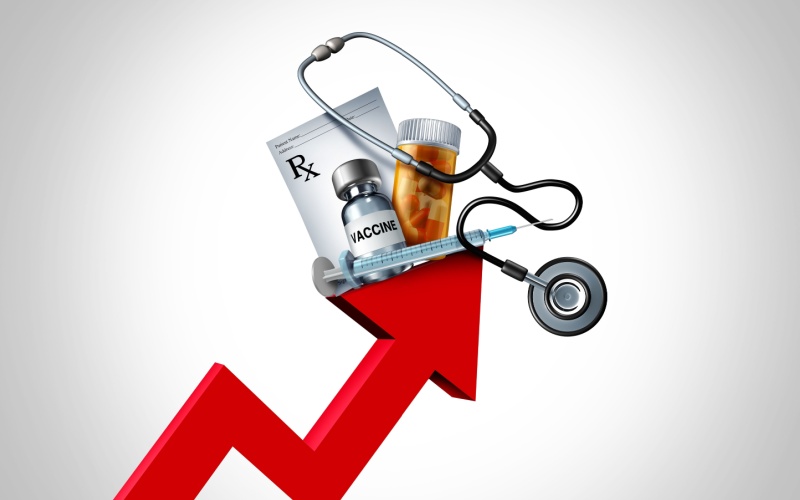Health care costs are projected to rise sharply again in 2026, with increases expected between 6.5% and over 10% according to multiple industry analysts. For example, Mercer forecasts a 6.5% average rise in total health benefit cost per employee, while The Business Group on Health projects a 7.6% increase. PwC expects medical costs to grow by 8.5% for a third consecutive year, and some estimates predict premium hikes as high as 15-20% for individual Marketplace plans. As the new year approaches, public sector employers should prepare for continued cost pressures driven by several key factors.
GLPS-1s
GLP-1 medications, such as Mounjaro, Ozempic, Rybelsus, Zepbound, and Wegovy, are driving significant increases in health plan costs. Originally approved for Type 2 diabetes, these drugs are now widely used for weight loss and are being evaluated for additional conditions. With monthly costs averaging $1,000 and many individuals using them long-term, employers face surging expenses as demand grows.
Recent studies show 12% of Americans have tried GLP-1 medications for weight loss, and usage is expected to rise with more drugs in development. Employers are responding by tightening approval processes and encouraging participation in weight management programs to help manage escalating costs.
Specialty Medications
Pharmacy costs remain a growing concern, with specialty medications continuing to drive significant health care inflation into 2026. This trend is fueled by an expanding specialty drug market, marked by a record number of FDA approvals and innovative therapies targeting complex, chronic, and rare conditions.
Industry projections indicate that nearly 80% of FDA approvals in 2025 are for specialty drugs, highlighting a shift toward targeted treatments such as biologics, biosimilars, and cutting-edge cell and gene therapies. The rapid introduction of biosimilars, 19 approved in 2024 and 10 more in 2025, offers employers cost-saving opportunities as exclusivity for original biologics expires.
Meanwhile, advancements in cell and gene therapy manufacturing are helping to address cost and scalability challenges, making these transformative treatments more accessible. While the complexity and costs of specialty drugs require thoughtful plan management, innovation in this space is accelerating, signaling continued change for benefits planning and administration.
Chronic Health Conditions
Chronic and mental health conditions account for the majority of U.S. health care spending, with heart disease, stroke, and obesity among the leading cost drivers. Cardiovascular diseases alone are expected to impact over 60% of older adults by 2050, potentially tripling related expenses to $1.8 trillion. Similarly, obesity affects more than two in five adults and is closely linked to additional costly conditions such as diabetes and sleep apnea, resulting in nearly $173 billion in annual medical expenses. As chronic disease rates continue to rise, managing these costs remains a critical concern for public sector organizations.
Aging Populations
The U.S. population is aging due to rising life expectancy and historically low birth rates. By 2055, life expectancy at birth is projected to reach 82.3 years, while the birth rate has dropped to less than 1.6 children per woman. As more individuals enter retirement age, health care costs are expected to climb, adults 65 and older use significantly more health care, accounting for a disproportionate share of spending due to higher rates of chronic conditions. This demographic shift will continue to drive up overall health care expenses for employers and public sector organizations.
Cancer Care
Cancer care has driven employer cost increases for four consecutive years, fueled by rising diagnoses and more expensive treatments. The increase affects not only older adults but also working-age employees and their families, many of whom now require long-term, intensive care. Advances in therapies such as immunotherapies, CGTs, and personalized medicine are improving outcomes, but these solutions carry substantial costs, often reaching hundreds of thousands of dollars per patient.
Medical Inflation
Rising costs continue to challenge organizations, with medical inflation now surpassing general inflation rates. In August 2025, the CPI’s medical care index reached 3.4%, outpacing overall inflation and highlighting increased pressure on health care affordability.
Recent research shows that nearly 29 million U.S. adults can’t afford or access quality health care, the highest level since 2021. More than one-third of Americans believe they’re paying too much for the care they receive. Additionally, employers are experiencing increases of over 10% due to rising demand, increased utilization, and other cost drivers not always reflected in standard inflation metrics.
Health Care Labor Costs
The shortage of health care workers, driven by increasing demand, an aging population, and fewer new entrants to the field, continues to impact costs. As labor expenses rise, these costs are often transferred to employers and, ultimately, to employees and their families.
Employer Takeaway
Health care benefits represent a major investment for organizations and their employees alike. While rising costs are a reality, employers who stay informed can anticipate trends and make proactive, strategic decisions. Download the bulletin for more details.

